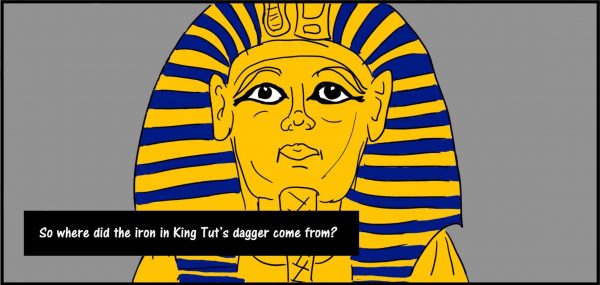6 July 2016
Drawn to Geoscience: Pharaoh’s Iron Dagger Made from a Meteorite, Study Confirms
Posted by Shane Hanlon
 This post is part of our Drawn to Geoscience series where our own JoAnna Wendel creates (and explain her process for) comics of stories published in AGU’s news website and magazine Eos. The news story, Pharaoh’s Iron Dagger Made from a Meteorite, Study Confirms, can be found on the Eos website.
This post is part of our Drawn to Geoscience series where our own JoAnna Wendel creates (and explain her process for) comics of stories published in AGU’s news website and magazine Eos. The news story, Pharaoh’s Iron Dagger Made from a Meteorite, Study Confirms, can be found on the Eos website.
When Elizabeth Deatrick, our news-writing intern, pitched this story about King Tut’s dagger, I thought “cool story, nice find!” and moved on mentally.
Then three days later my eyes popped open in the middle of the night and I thought, “Duh, this would make an excellent comic! It’s got all the elements—science, ancient Egyptian kings, and space.” I couldn’t believe I hadn’t seen it before.
The story, if you haven’t read it (and you definitely should!), is about how the iron in King Tut’s dagger is definitively from a meteorite. Scientists had suspected this before, because iron was rare to the ancient Egyptians, but 1990s-era technology indicated otherwise. With a new more powerful instrument for a technique called x-ray fluorescence , the paper’s authors bombarded the dagger with x-rays that caused it to release photons with which the scientists could characterize the types and amounts of elements in the object.
So Elizabeth and I sat down to talk about the script. As a new science comics maker myself, I had a hard time explaining to her how she should boil down her 700-word story into a 2-page comic. In the end I suggested that she take the main point of each paragraph and shrink it down to 1–2 lines, then we’d go from there.
In our first script, we left out the specific science of how x-ray fluorescence worked. I didn’t think it was necessary. I thought the main points were “King Tut’s dagger is cool,” “Iron was rare for ancient Egyptians,” “Scientists did a thing and found it was meteoritic iron.” But as I started mapping out the comic itself, I realized that really important pieces were missing, like:
- “What is a meteorite and how is that different than a meteor?”
- “What makes a meteorite with iron in it different than a terrestrial rock with iron in it?”
- “What did the scientists even DO?”
I realized I got too caught up in the historical pieces of the story and had forgotten to include the science pieces.
When trying to represent the meteorite bit, I thought about drawing a panel showing the different stages of a space rock as it approaches Earth (meteoroid), enters Earth’s atmosphere (meteor), and hits the Earth’s surface (meteorite). But the reader doesn’t necessarily need to know all this, just that a meteorite is a meteor that’s hit Earth’s surface. So, when I reveal that Tut’s dagger contains iron from space, I drew a meteor—which motion lines around it to depict its entry into Earth’s atmosphere—and in the next panel, I just clarified that a meteorite is a meteor that’s hit Earth.
When thinking about x-ray fluorescence, I assumed it was a giant, blocky grey machine that they put the dagger into. But it turns out the technique can be done with a little portable instrument, so that was easy enough to recreate in a drawing. When you look up “x-ray fluorescence” on Google Images, you get a lot of illustrations of x-rays as straight lines hitting an object, while squiggly lines of returning photons emerge from the object. I simply recreated this concept, using different colors to represent x-rays coming from the instrument and photons from the dagger.
This comic turned out to be way more expansive than I thought, but in the end I think I found a good balance of science and story.
—JoAnna Wendel is an Eos Staff Writer



 The Plainspoken Scientist is the science communication blog of AGU’s Sharing Science program. With this blog, we wish to showcase creative and effective science communication via multiple mediums and modes.
The Plainspoken Scientist is the science communication blog of AGU’s Sharing Science program. With this blog, we wish to showcase creative and effective science communication via multiple mediums and modes.